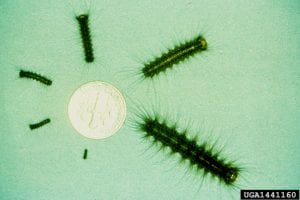Last year, numerous blueberry and strawberry fields were set back by spongy moth caterpillars. Spongy moths, or Lymantria dispar, are an invasive pest in the United States. Right now, tiny, black, fuzzy caterpillars are drifting down from trees on little threads of webbing. You might notice them landing on you if you are out in the field, especially near a tree line.
At this early life stage, we recommend spraying DiPel BtK (Active ingredient Bacillus thuringiensis subspecies kurstaki), or DiPel aizawai (active ingredient Bacillus thuringiensis subspecies aizawai) to control the caterpillars. When applied to leaves, the bacteria in DiPel create a protein that crystalizes in the digestive tract of the larvae, eventually killing them. Thus, the larvae need to eat leaves that are coated with DiPel for the pesticide to take effect. As larvae get older, their digestive systems become more robust. By the time you can see colorful splotches on the spongy moth larvae, a DiPel spray is more likely to slow them down than to kill them.
Spongy moths typically have only one generation a year. Their larvae overwinter on spongy-looking egg masses on tree bark and other rough textured structures. While spongy moths have lived in the United States for over 100 years, their populations can only become noticeable in certain years.
The hot, dry weather we had early last summer let massive numbers of caterpillars grow into adults and mate. By the time we had constant rains in July, the next generation was safely tucked away into egg masses. Now that we are having another hot, dry spring, the spongy moths are emerging again and they are feeling wonderful. We do have several days of rain in the forecast which might slow the caterpillars down, but I’d recommend having some DiPel available if the populations persist past this week.

